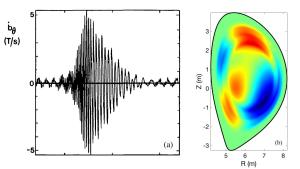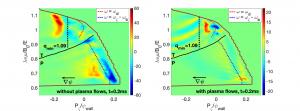Increasing fusion performance with energetic-particle-driven instabilities
New results published in Physical Review Letters suggest that instabilities driven by energetic particles can have a positive impact on fusion performance.
In the 150-million-degree burning plasma of the ITER tokamak, a fraction of the particles will be even hotter—with temperatures on the order of 15 billion °C. These energetic particles, born from fusion reactions or the auxiliary heating systems, are essential to maintaining the self-heating of the plasma, key to achieving high performance in future fusion reactors.
However, the presence of energetic particles can drive instabilities in the plasma core, such as the so-called "fishbone" instability that is named for the way it appears on the magnetic measurements (see Fig. 1). If the amplitude of this instability is large enough, it can lead to a redistribution of energetic particles out of the plasma core, deteriorating the plasma's self-heating process.
Through an international collaboration involving researchers from the ITER Organization, the United States, France and China, scientists have shown for the first time that the amplitude of the fishbone instability can be significantly reduced by the self-generation of strong flows within the plasma (see Fig. 2). This research was carried out using state-of-the-art plasma simulation software developed at the University of California Irvine, the Princeton Plasma Physics Laboratory and the École Polytechnique in Paris. The simulations described an experimental plasma discharge from the DIII-D tokamak at General Atomics (San Diego, USA) that was chosen to capture the dynamics of energetic particles in ITER. This experiment featured a sharp increase of plasma performance during the excitation of fishbone instabilities.
By allowing the fishbone to self-generate plasma flows in the simulations, the plasma software models were able to recover, for the first time, the experimental observations for the fishbone amplitude and the fraction of energetic particles that were redistributed. Moreover, the plasma flows in the simulations were strong enough to suppress the turbulent transport in the plasma core, which accounted for the observed sharp increase of plasma performance in the DIII-D experiment. Similar simulation results were obtained in predictions for the ITER tokamak.
These results, published¹ last week in Physical Review Letters, show that instabilities driven by energetic particles can have a positive impact on fusion performance and that they are not always detrimental. It opens the door for the development of high-performance scenarios in ITER that utilize this novel physics of plasma flow generation by fishbone instabilities.
¹G. Brochard (Monaco-ITER Postdoctoral Fellow), C. Liu, X. Wei, W. Heidbrink, Z. Lin, N. Gorelenkov, C. Chrystal, X. Du, J. Bao, A. R. Polevoi, M. Schneider, S. H. Kim, S. D. Pinches, P. Liu, J. H. Nicolau, and H. Lütjens. Phys. Rev. Lett. 132, 075101 — Published 16 February 2024



